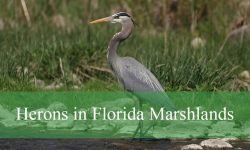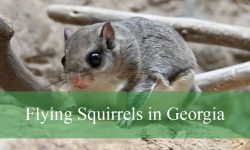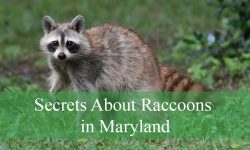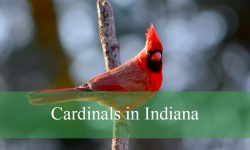Spider species come in various colors and patterns, and some of the most striking ones are black spiders with white spots. These unique markings not only make them visually distinct but also serve specific purposes in their survival strategies, like camouflage or communication. If you’ve encountered a black spider with white spots and want to learn more, you’re in the right place!
In this article, we will explore 26 black spiders with white spots, their identification features, and interesting facts about them.
Introduction to Black Spiders with White Spots
Black spiders with white spots are often found in different environments, ranging from gardens and forests to urban areas. These spiders belong to various families and genera, each with its own unique traits. While some are harmless, others, such as the infamous Latrodectus mactans (Southern Black Widow), can be dangerous to humans. Understanding how to identify these spiders is crucial for both safety and knowledge.
How to Identify a Black Spider with White Spots
To identify black spiders with white spots, look for the following key features:
- Coloration: As the name suggests, the body of these spiders is predominantly black.
- Spots/Markings: The white spots can appear as small dots, bands, or patterns across their abdomen or legs.
- Size and Shape: Spiders vary in size, but many of these species are medium to large-sized with long legs.
- Habitat: Some black spiders with white spots prefer wooded areas, while others may be found in dark corners of homes.
Different Types of Black Spiders with White Spots
Gray Wall Jumping Spider
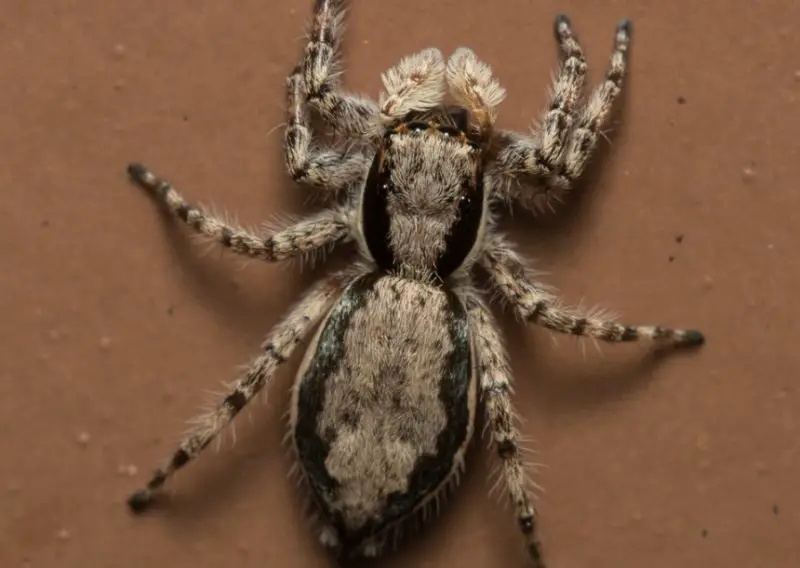
The Gray Wall Jumping Spider (Menemerus bivittatus), originally from Africa, has established populations in several parts of the US, including Texas, California, and Florida. Known for its agility and exceptional jumping ability, this species skillfully hunts prey such as crane flies. Males are easily recognized by their bold black and white coloration, featuring horizontal stripes across their bodies, while females, reaching up to 10 mm in size, have more subdued markings.
During mating, males engage in complex courtship rituals, sometimes producing distinct sounds to attract females. These spiders are commonly found on walls and tree trunks, where their excellent climbing skills help them hunt flies drawn to artificial lights and windows, making them effective natural pest controllers.
Bronze Jumping Spider
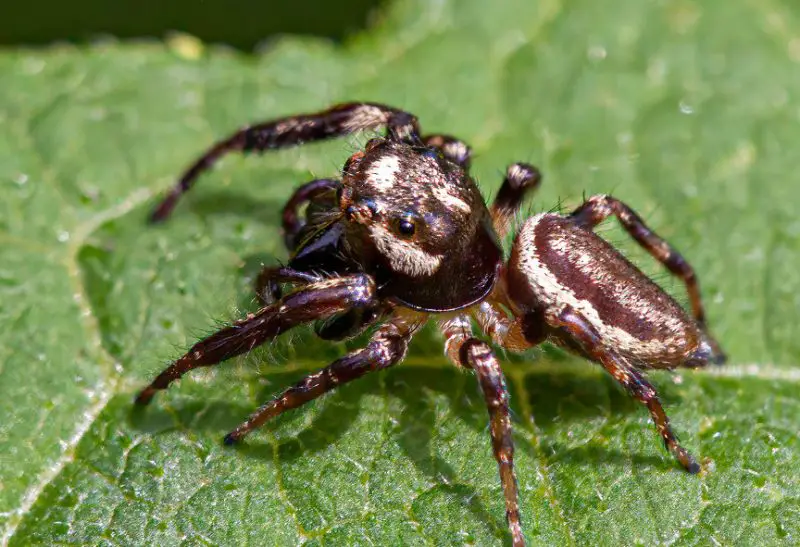
The Bronze Jumping Spider (Eris militaris) gets its name from its distinctive bronze coloration, which stands out against the dominant black and white hues on its cephalothorax. Males display more vivid colors and a strong black-and-white contrast. These spiders are easily recognized by their black cephalothorax, accented with a white band along the sides, and bronze-colored hairs covering their legs. Equipped with two large central eyes and two smaller lateral ones, they have excellent vision, making them skilled hunters on various surfaces.
Often found near homes, particularly around lights and windows, these spiders are active predators. While they may exhibit aggressive behavior when threatened, their bites cause only momentary discomfort and pose no real danger to humans.
False Black Widow
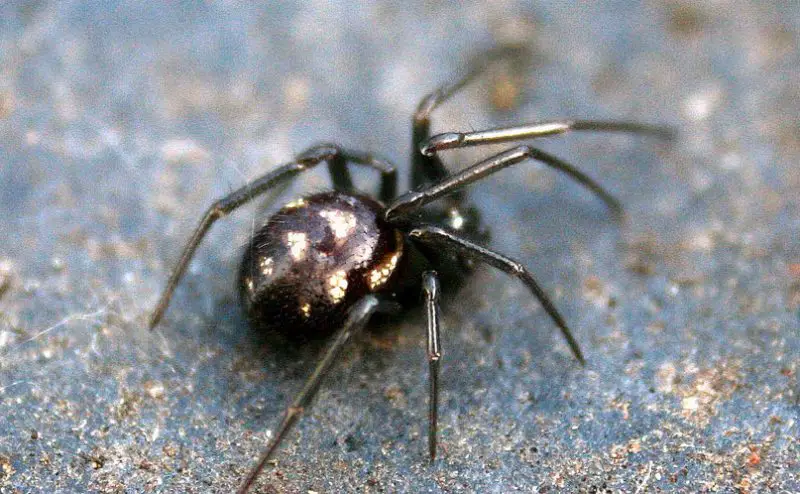
The False Black Widow (Steatoda grossa) exhibits a brown color in females, while males are a combination of black, white, and brown. They can grow up to 10.5mm in size. Found in various locations, they construct webs in any suitable space. Despite having poorer eyesight than many other species, they depend on vibrations in their webs to sense potential prey.
Although they may bite if provoked or mishandled, their venom is not fatal, but it can lead to symptoms in humans such as fever, swelling, sweating, and nausea.
While not as dangerous as the Redback Black Widow, bites can still happen unexpectedly if the spider is mistaken for prey.
Peppered Jumping Spider
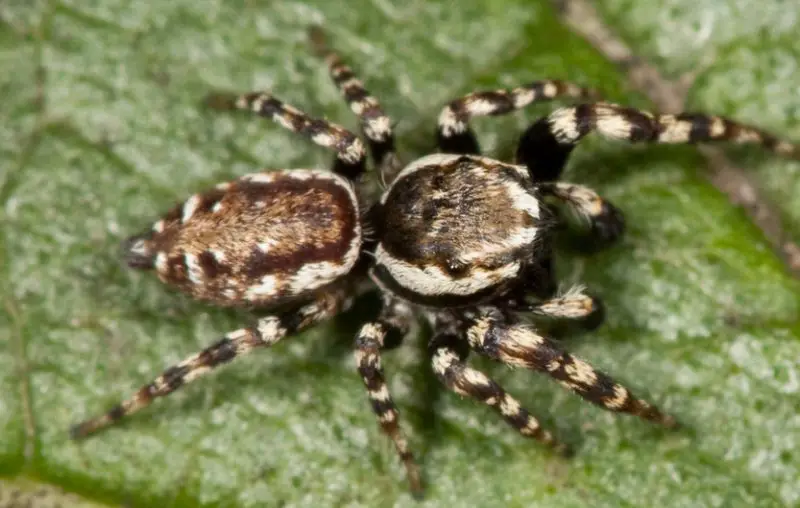
The Peppered Jumping Spider (Pelegrina galathea) is one of the tiniest black-and-white spiders in North America. Males are as small as 2.7mm, while females can grow up to 5mm. With black cephalothoraxes adorned with striking white markings, they are commonly spotted in US crops and agricultural fields across the globe, where they likely contribute to natural pest control.
Known for their agility, these spiders are skilled climbers and are often found on vertical surfaces, such as walls, in search of food. They are particularly abundant in abandoned crops and farms, where they thrive and play a key role in maintaining balance in the ecosystem.
Buttonhook Leaf-Beetle Jumping Spider
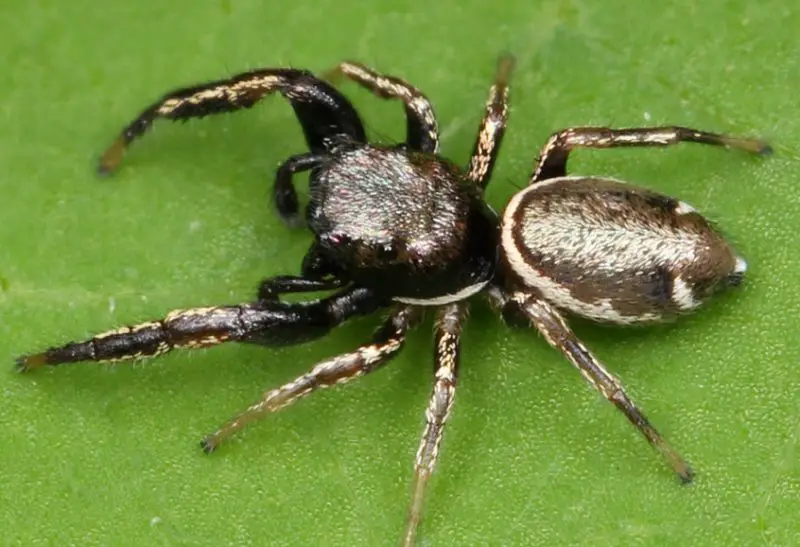
A common sight in the United States, the Buttonhook Leaf-Beetle Jumping Spider (Sassacus vitis) is distinguished by its small size compared to other jumping spiders. Usually females are above 5mm and males are about 4mm. Their multicolored bodies are primarily black and white, with brown or bronze accents frequently added. They are distinguished by their legs’ white markings and their black cephalothorax with linked white stripes around the sides.
They usually hunt gnats, using their agility and hunting skills to catch these minute insects, preferring smaller prey because of their size.
Pantropical Jumping Spider
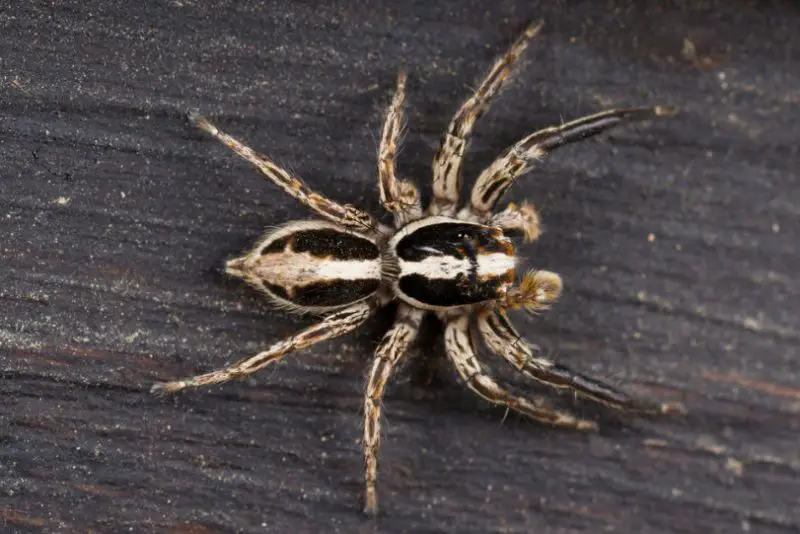
Originating in Asia, the Pantropical Jumping Spider (Plexippus paykulli) has spread to other parts of the world. Males and females have different coloring, with males having a black cephalothorax with a white central line (tan in females) and females having more noticeable brown colors.
Known for their extraordinary hunting abilities and acute vision, they prefer to use tiny silk cocoons for refuge rather of traditional webs. Mostly found in citrus groves in Southern regions, they use strong venom to swiftly immobilize their prey, which includes mosquitoes, other spiders, and larger insects.
They can effectively approach a variety of prey species thanks to their keen vision, whether they are stalking fly larvae or quickly jumping on flies.
Bowl-And-Doily Spider
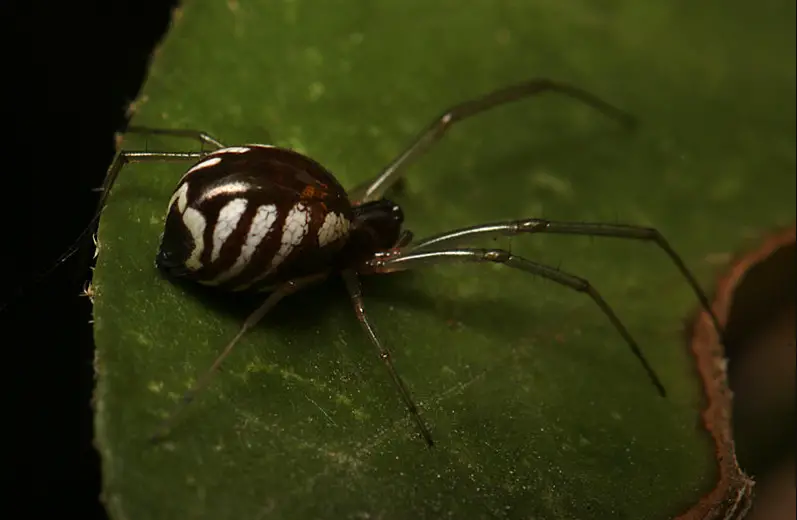
North America has seen the introduction of the Bowl-and-Doily Spider (Frontinella pyramitela), which specializes in creating webs to capture tiny flies and gnats. Even though they are only 5 mm in size, their variegated coloring makes it difficult to identify them around the house. Males may have reddish-brown legs and black and white bodies.
Males usually leave the female’s nest immediately after mating, however departure times can vary. They are solitary by nature and only come together for mating. Because of their remarkable prey recall, they are able to recognize current prey parts even when they are combined with older ones.
Sylvan Jumping Spider
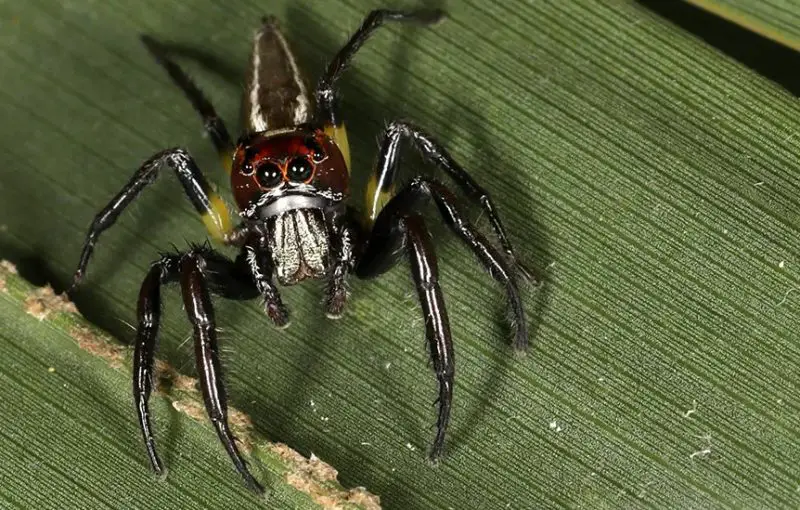
Male Sylvan Jumping Spiders (Colonus sylvanus) have a black and white body with a brown abdomen and red eye markings, while females are tan with white patterns on the cephalothorax. This sexual dimorphism is particularly noticeable. They are probably endemic to their surroundings and are frequently found in trees and flowers, with all-black legs.
They are about 5 mm in length and mostly eat small insects, such as gnats. The two largest and most noticeable of its eight eyes are located in the center and provide crucial visual information for hunting and navigation.
White Micrathena
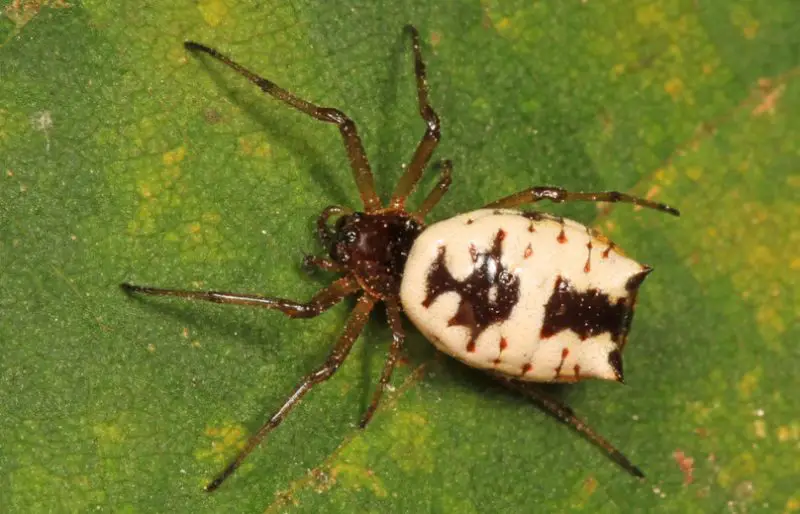
One of the most prevalent Micrathena species in the United States is the White Micrathena (Micrathena mitrata), which is distinguished by its bulbous, black and white body with spiky protuberances on the lower abdomen. It may grow up to 0.5 inches and feeds on a variety of tiny insects, catching gnats and mosquitoes in its enormous spider webs.
The centerpoints of these webs, which are well-known for their efficiency, are especially good at catching larger insects. They can be found in gardens and are useful companions in outdoor settings since they help manage plant pests and mosquito populations.
Common White-Cheeked Jumping Spider
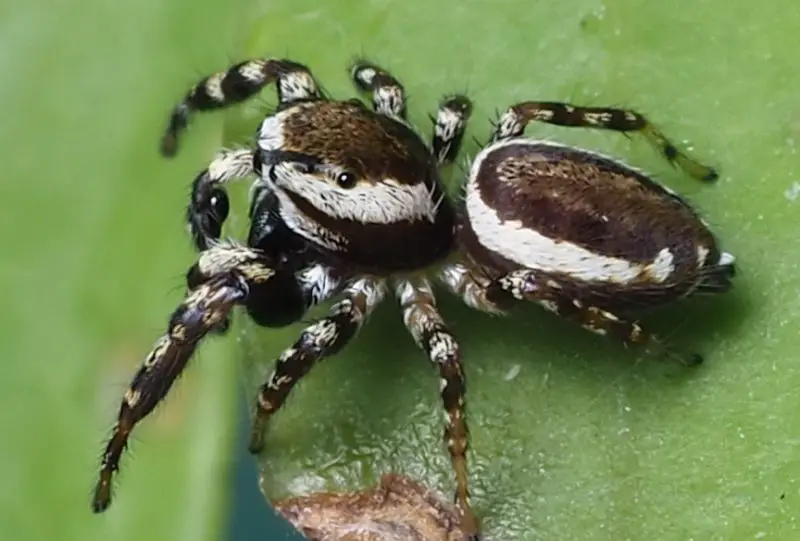
The Eastern United States, especially the Boston area, and Eastern Canada are home to a large population of Common White-Cheeked Jumping Spiders (Pelegrina proterva), whose range is also growing to include Montana.
There is clear sexual dimorphism, with females having light brown and white or tan coloring and males having dark brown or black and white coloring. They are similar in size to other members of their genus, with males average 4.2mm and females 5.6mm. They have the thick, hairy bodies that are characteristic of many jumping spiders.
They aid in the natural control of pests in their environments by feeding on a range of insects, including common houseflies.
Long-Palped Ant-Mimic Sac Spider
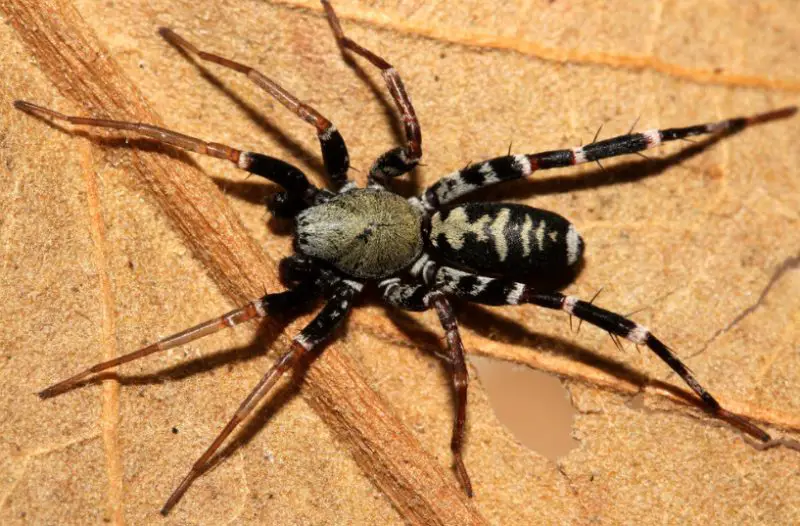
In order to ward off predatory spiders, the Long-Palped Ant-Mimic Sac Spider (Castianeira longipalpa) mimics ants, hence its name. Although they pose no threat to humans, they are skilled hunters. Males have primarily black bodies with white or tan markings, while females are brown and black in hue.
They hunt tiny insects among grass, plants, and flowers rather of weaving webs like other sac spiders do. Ants use their lengthy bodies for mimicry, which helps them blend in with their environment and avoid any predators.
Two-Lined Stealthy Ground Spider
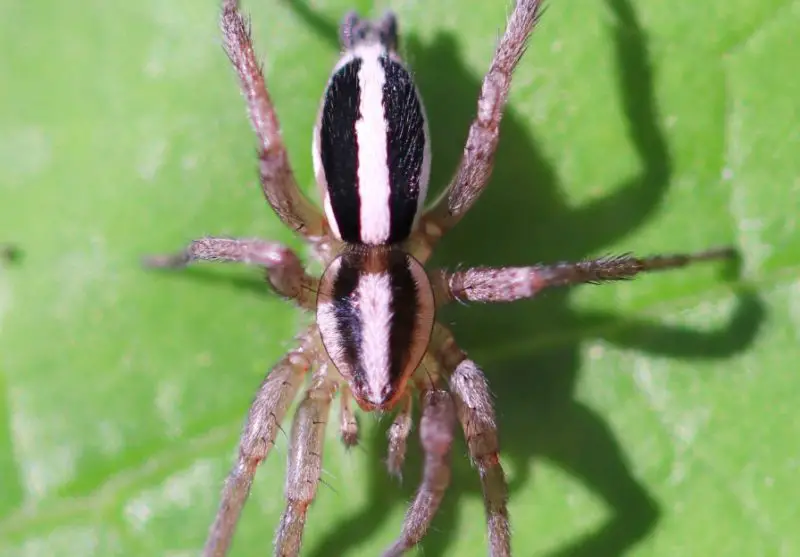
The body of the Two-Lined Stealthy Ground Spider (Cesonia bilineata) is characterized by a longitudinal white stripe flanked by two black stripes. They live in attics, basements, and abandoned buildings and thrive there by feeding on insects drawn to moisture.
Their venom, which mostly immobilizes small victims, is poisonous yet harmless to humans. Originally from Eastern states, they are now prevalent in California and other western places. They prefer to run away from people and are not hostile toward them.
Nordmann’s Orbweaver
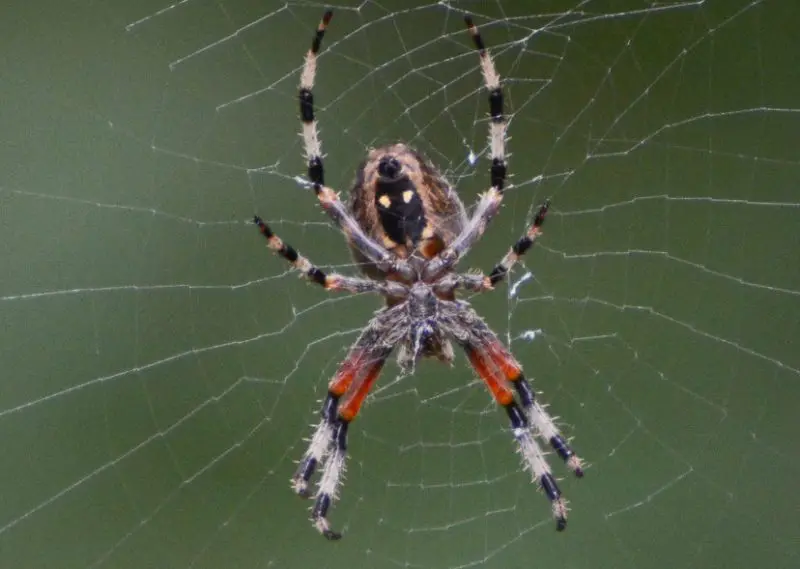
One of the largest orbweavers in North America and Europe, the Nordmann’s Orbweaver (Araneus nordmanni) is a unique and striking sight, reaching up to 13mm. It can be identified by its black body and legs with white marbled markings. It can climb quickly and builds vertical orbital webs high on tall grass or trees.
A wide range of insects, including gnats, flies, and wasps, are entangled in these webs. The dominating female frequently holds the middle position in the web during the infrequent observations of this species, occasionally finding cover under branches during periods of intense precipitation.
Bold Jumping Spider
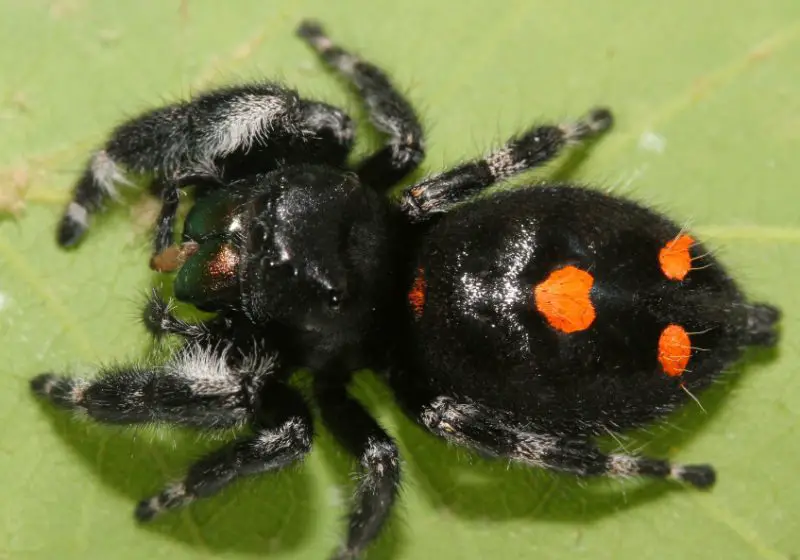
The bold jumper, or Bold Jumping Spider (Phidippus audax), is distinguished by its eye-catching black and white coloring. Usually black in color, some have white stripes running over the dorsal surface. These venomous spiders, which are found in prairies and grasslands, are not dangerous to people but will bite if they are handled aggressively.
They hunt throughout the day and use their keen vision to find their prey, frequently swooping down on insects and tiny spiders. These spiders, which typically lay 200 eggs in a season in the spring or summer, are essential for controlling insect populations.
Spinybacked Orbweaver
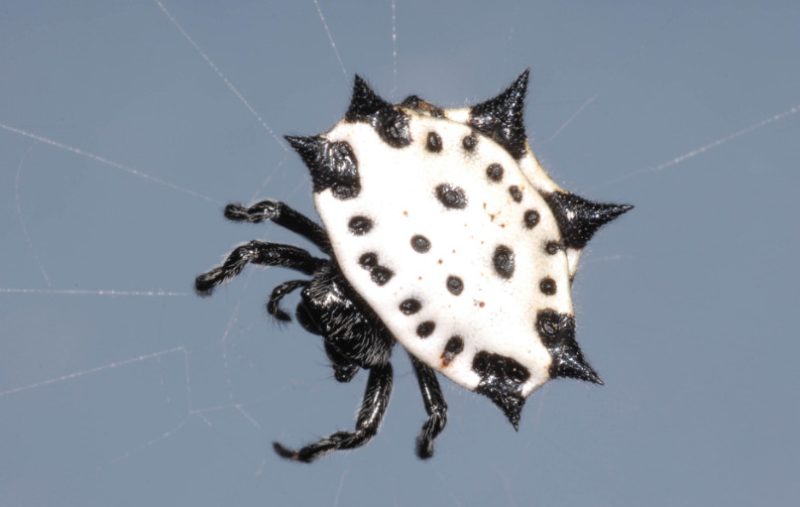
The remarkable black and white coloring of the Spinybacked Orbweaver (Gasteracantha cancriformis), with white predominating on its dorsal surface and accented with tiny black dots, makes it easy to identify. The six abdominal projections that give this species its unusual and asymmetrical appearance are what really make it unique.
These spiders, which are frequently found in colonies of thousands, do best in wooded areas with a lot of flora, especially in warm regions like Florida. Although they are frequently seen in citrus farms, their habitat is widely distributed, extending from South America to the southern US territory.
Spined Micrathena
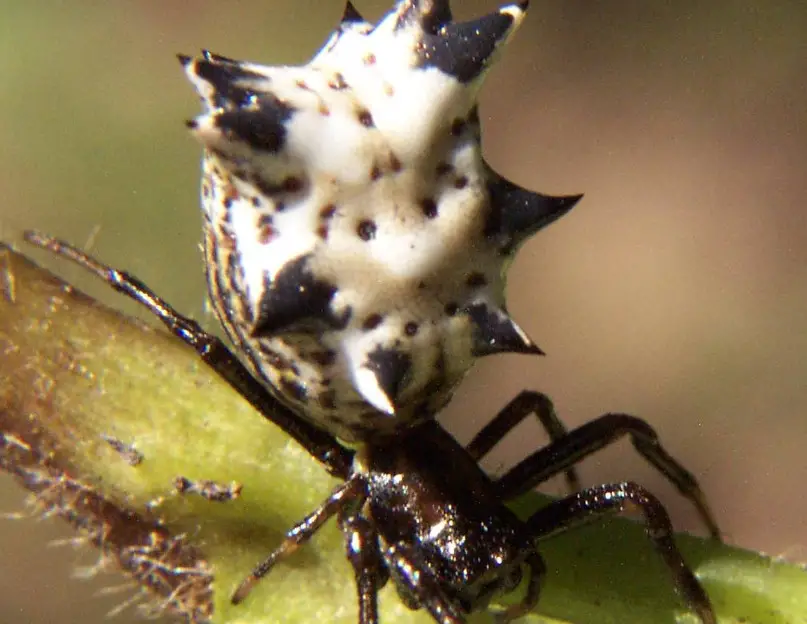
The characteristic ridges on the female’s body, which are thought to have a defensive purpose against predators, identify the Spined Micrathena (Micrathena gracilis), sometimes referred to as the castleback orbweaver. Only seen in females, these spines have the ability to hurt potential assailants. Males, on the other hand, have more noticeable black and white coloring. Depending on its habitat, this species can have a variety of colors, including orange and brown, although it is usually black and white.
These non-aggressive spiders, which can reach a length of 10 mm, are renowned for their daily reconstruction of orb-shaped webs. They are venom-free, active until October, and flourish in a variety of environments that allow them to adhere to webs.
Zebra Jumping Spider
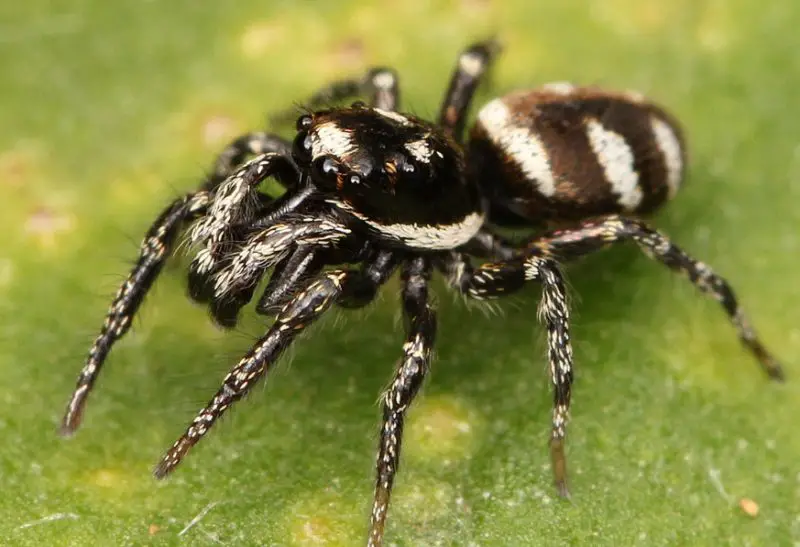
The Zebra Jumping Spider (Salticus scenicus) is one of the largest species among black and white jumping spiders. Its distinctive hairy body features a well-balanced pattern of black and white, with minimal variation in appearance.
Females grow larger than males, reaching up to 9 mm, while males typically reach a maximum size of 5 mm. These spiders are widespread across North America, Europe, and parts of Asia. Unlike web-spinning spiders, they rely on their exceptional vision to hunt. Their keen lateral eyes detect movement, allowing them to capture prey, including surprisingly large insects like moths.
Zebra Jumping Spiders are highly adaptable and commonly found near trees, buildings, and even coastal areas like beaches, thriving in a variety of environments.
Twin-Flagged Jumping Spider
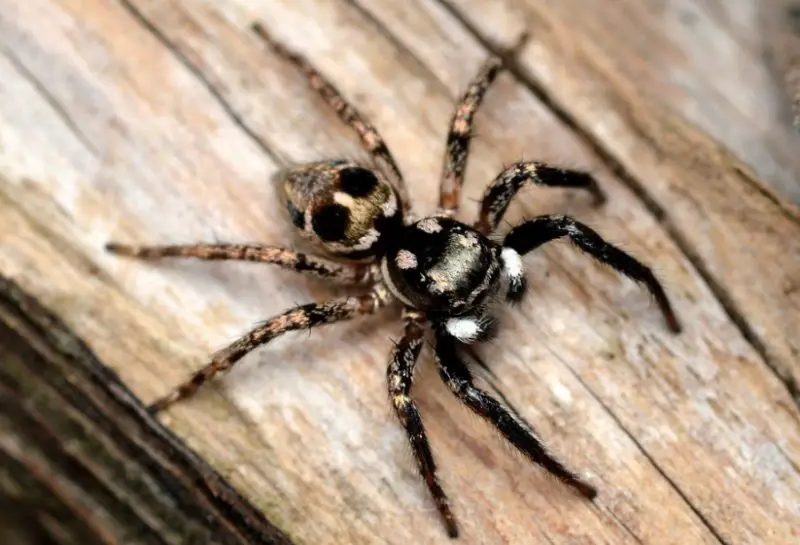
The Twin-Flagged Jumping Spider (Anasaitis canosa) is easily recognized by its black body covered in white setae, often displaying up to four white markings on the cephalothorax. However, its appearance can vary, with differences in color and pattern influenced by environmental factors.
Unlike web-building spiders, this species relies on active hunting to catch its prey. It is commonly found on the forest floor, where it stalks insects with precision. Though primarily a woodland dweller, some individuals may enter man-made structures such as homes, basements, and attics in search of food. At night, they are occasionally drawn to artificial lights, where insects tend to gather, providing an easy hunting ground.
Coppered White-Cheeked Jumping Spider
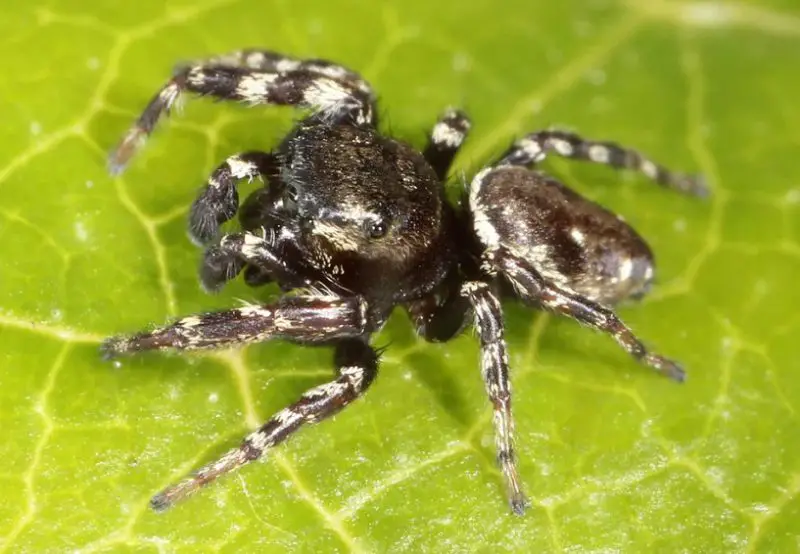
The Coppered White-Cheeked Jumping Spider (Pelegrina aeneola) is known for its striking blend of black, white, and brown coloration. Females are predominantly white, while males display a darker appearance with black as the dominant color. Female spiders have white legs accented with brown and black markings, whereas males feature a black body with white spots and black-and-white patterned legs.
Slightly larger than males, females reach up to 5.5 mm, while males grow to about 5 mm. Both sexes possess four principal eyes, with the central pair being noticeably larger, giving them excellent vision for hunting. Primarily found in the western United States, these agile hunters prey on insects and their eggs, playing a crucial role in controlling pest populations.
Red-Femured Spotted Orbweaver
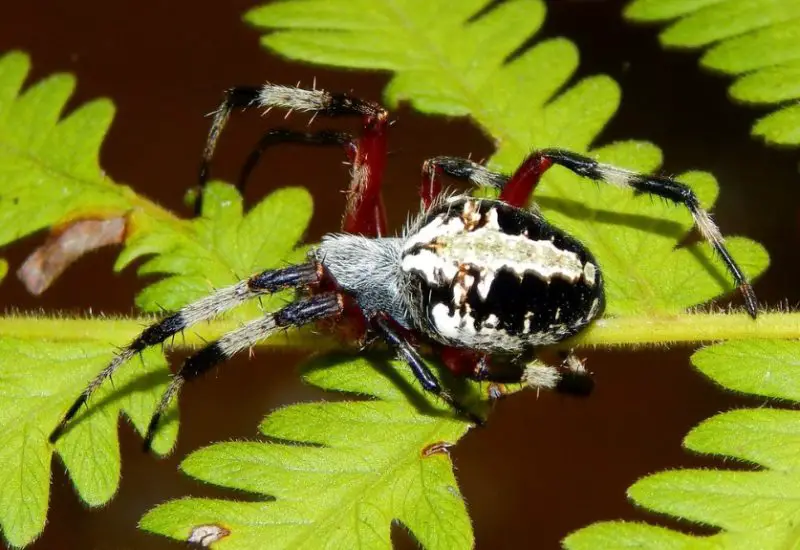
The Red-Femured Spotted Orbweaver (Neoscona domiciliorum), commonly known as the spotted orbweaver, is easily recognized by its black and white body contrasted with striking red legs. As a true orbweaver, it constructs large vertical webs to capture insects, typically spinning them in the evening and dismantling them by morning. During the summer, females may leave their webs intact throughout the day, likely to meet their increased nutritional demands for mating.
Primarily nocturnal, these spiders are often difficult to spot, even in their preferred hardwood forest habitats. However, they occasionally venture into suburban areas at night, staying hidden from view while hunting for prey under the cover of darkness.
Eastern Parson Spider
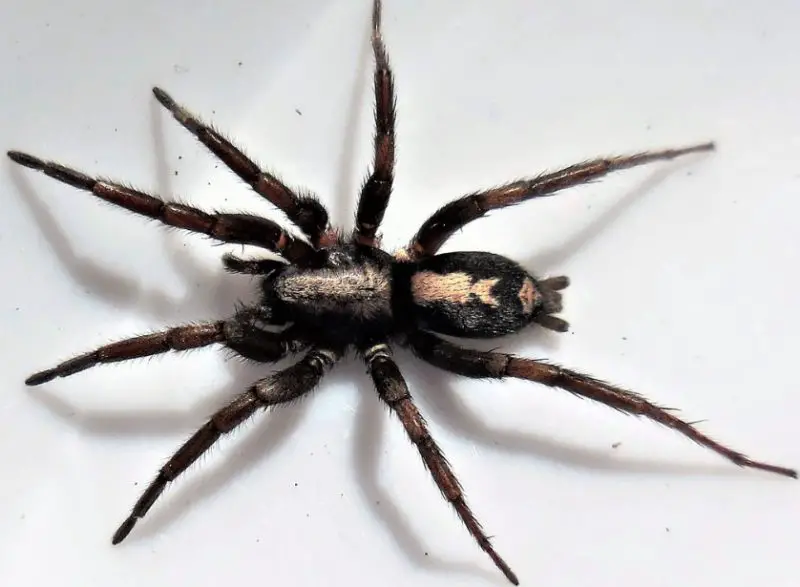
The Eastern Parson Spider (Herpyllus ecclesiasticus) is easily recognized by its distinctive white, necktie-shaped marking on a black body. Widespread across North America, this agile hunter does not rely on webs to catch prey. Instead, it actively stalks and ambushes insects, often hiding under rocks, wood, and leaves during the day. While some people may report bites, these spiders are non-venomous and pose no medical threat.
Fast-moving and highly adaptable, the Eastern Parson Spider occasionally enters homes in search of food but remains harmless to humans. Outdoors, it is most active at night, frequently seen on flat and vertical surfaces, particularly near artificial lights where insects gather, making it an effective natural pest controller.
Noble False Widow
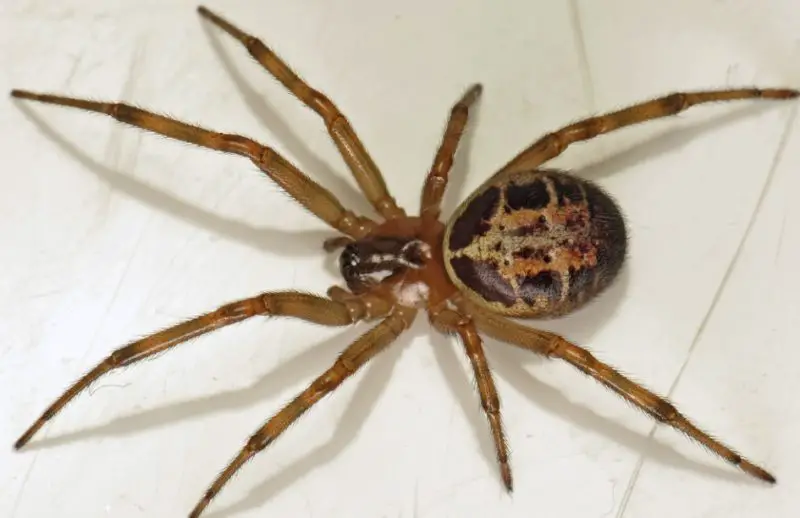
The Noble False Widow (Steatoda nobilis) is known for its impressive predatory skills, earning a reputation as one of the most formidable spiders. It constructs strong cobwebs to trap a wide range of prey, including insects and even small mammals like bats. Using potent venom, it swiftly paralyzes its victims, making them easy to consume.
Highly adaptable, this species thrives in various environments, from outdoor spaces to indoor areas where it readily establishes itself. Its ability to quickly subdue prey and adjust to different habitats highlights its effectiveness as a predator, making it a resilient and resourceful species in the spider world.

